Transform fresh cauliflower into flavorful homemade ferments with our simple and foolproof fermented cauliflower recipe bursting with healthy probiotics. Perfect for both beginners and fermentation enthusiasts, this guide offers easy steps to achieve a tasty and nutritious result.
After mastering fermenting other vegetables such as fermented tomatoes, dill cucumbers, beets, sauerkraut, and a refreshing fermented watermelon, it’s time to explore the benefits and vibrant flavors of lacto-fermented cauliflower.

Health Benefits of Fremented Cauliflower
There are health-boosting perks of adding fermented cauliflower to your diet:
- Probiotic Rich: Supports gut health with beneficial bacteria.
- Nutrient Absorption: Fermentation enhances the bioavailability of nutrients.
- Boosts Immunity: A healthy gut microbiome ensures better communication between the immune cells and microbiota, thereby enhancing the body’s ability to ward off infections and diseases.
- Aids Digestion: The fiber content eases digestion and prevents constipation.
For more detailed information feel free to read this study looking into effects of fermented vegetable consumption on human gut.

Fermented Cauliflower Recipe
Creating your own fermented cauliflower recipe can be rewarding and delicious. The health benefits and delightful tang that accompanies each bite makes it worth trying.
To create a successful batch of fermented cauliflower, you’ll need the following ingredients, each serving a unique purpose.
Ingredients
- Cauliflower: Whether it’s the common White, vibrant Purple, sweet Orange, nutty Romanesco, or the mild Green Broccoflower, all varieties of cauliflower are suitable for fermenting, offering a delightful range of flavors and colors.

- Sweet and optional hot peppers: To add a colorful zest and enhance the visual appeal and taste. The natural sweetness (or heat) balances the tangy flavors of fermentation, resulting in a delightful and flavorful blend.
- Bay leaves, garlic, and fresh parsley: For a fragrant aroma and subtle depth of flavor also contributing tannins of herbs may help maintain the crispness of the vegetables.
- Black peppercorns, mustard seeds, coriander seeds, and dill seeds: These spices infuse the brine with complexity.
- Salt and water brine solution (3-4%): Essential for lacto-fermentation, it inhibits harmful bacteria while allowing beneficial bacteria to thrive. Sea salt or kosher salt without additives is ideal for fermenting cauliflower. And chlorine-free water ensures the beneficial bacteria thrive.
- Sauerkraut juice(optional): A teaspoon accelerates fermentation, ensuring a faster and successful batch.

How To Make Fermented Cauliflower: A Step-by-Step Guide
Here’s a simple guide on how to ferment cauliflower, ensuring you reap the most fermented cauliflower benefits:
- Prep Your Ingredients: Cut cauliflower into bite-sized florets and chop your sweet or hot peppers. Make sure everything has the same size. To fill a 1-gallon mason jar, which is equivalent to 128 fluid ounces or about 3.78 liters, you would typically need around 2 to 3 pounds (0.9 to 1.4 kg) of cauliflower florets. The exact amount can vary depending on the size and shape of the florets, as well as how tightly they are packed into the jar.
- Create the Spice Mix: Combine black peppercorns, mustard seeds, coriander seeds, and dill seeds. I’m using 2 teaspoons of each.
- Assemble: In a clean fermentation jar, layer the cauliflower, peppers, spice mix, garlic, parsley, and bay leaves.
- Prepare the Brine: Dissolve salt in water to create a brine solution. The salt-to-water ratio in a brine affects taste and fermentation speed. I usually use a 3% brine for fermenting cucumbers, but here I like the cauliflower to be tangier and I’ll be using a 4% brine solution (2.4 tablespoons of sea salt (or 2.7 tablespoons if using Celtic sea salt) in 4.2 cups of water which is ~1000 ml). For a 1 gallon jar you’ll need about 2000 ml of brine.
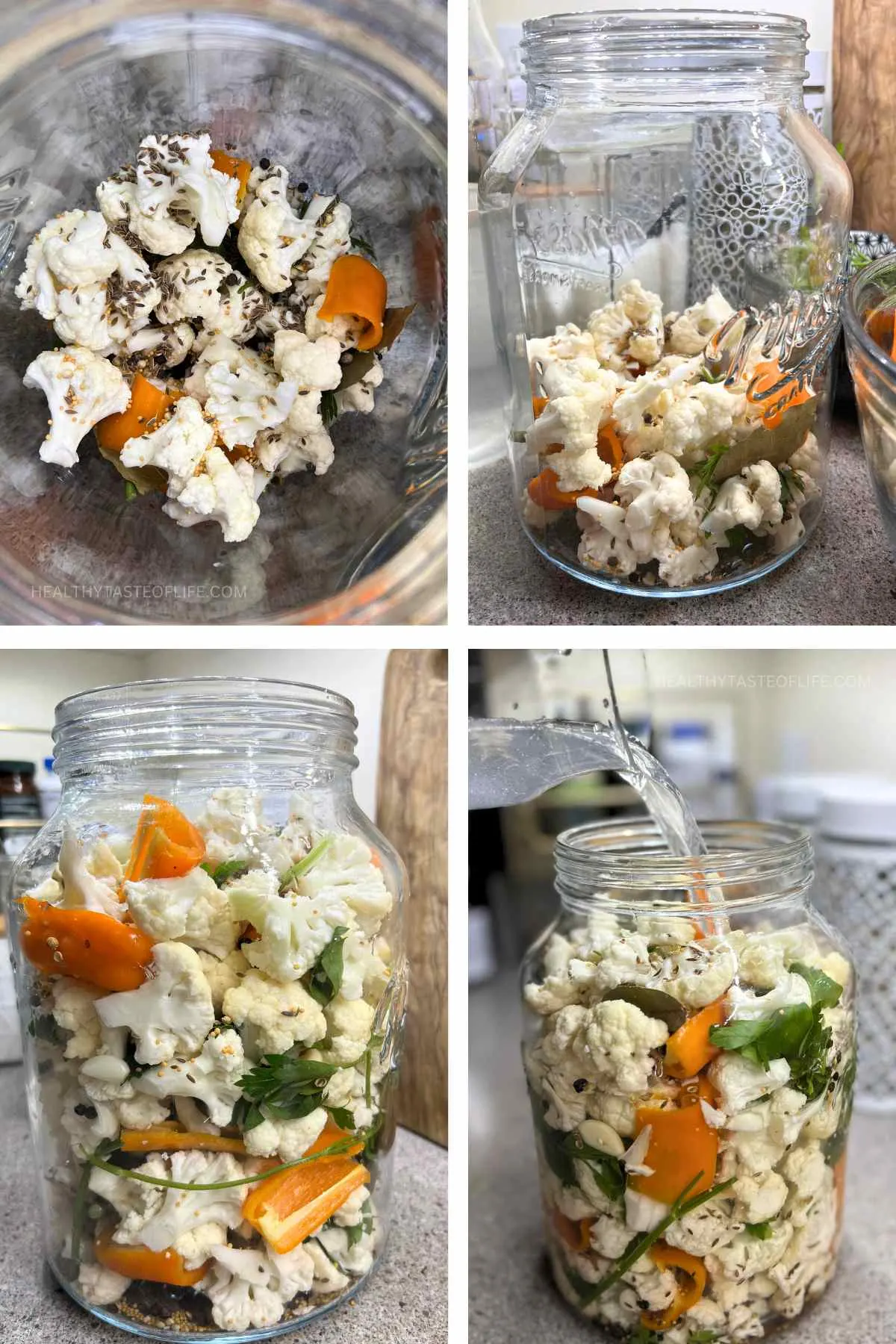
- Submerge: Pour the brine over the vegetables, ensuring they are fully submerged.
- Ferment: Place a clean, food-grade weight on top of the veggies after packing them into your jar. This weight will help keep everything below the surface of the brine. Aand let it sit at room temperature for 1 week or so, checking occasionally. A higher room teperature will speed up the fermentation process.
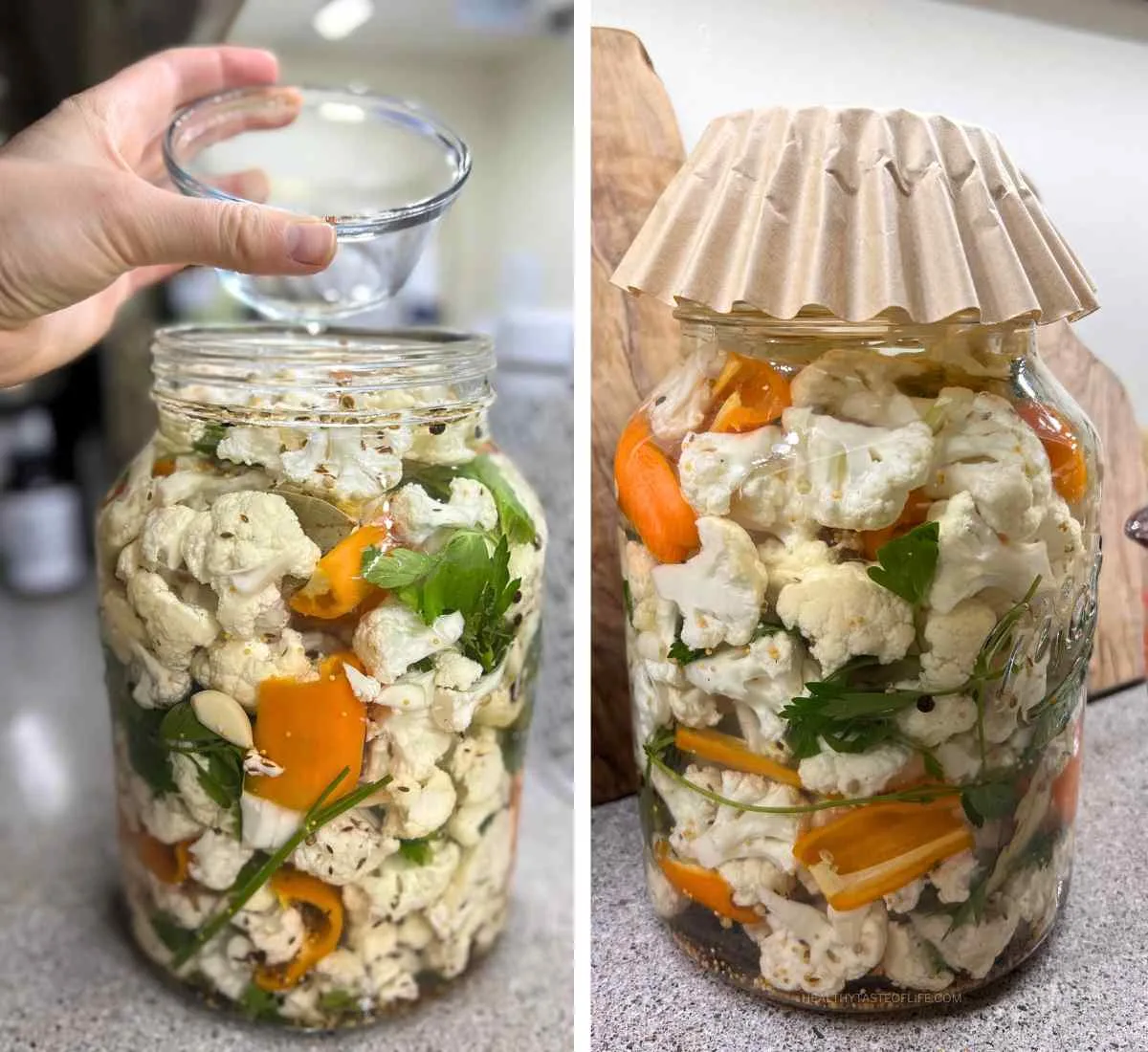
- Taste and Store: Once fermented to your liking, transfer to the refrigerator.
Tips, Storage, and Savory Combinations
- Tips: Ensure all utensils are clean to avoid contamination. Keep the veggies submerged to prevent mold. Also adding a touch of sauerkraut juice to your brine can be a game-changer in fermentation! This juice is rich in beneficial lactic acid bacteria, which can kick-start the fermentation process and ensure a successful ferment. Just a tablespoon or two is enough to give your brine that fermentation boost!
- Storage: Store your lacto-fermented cauliflower in the refrigerator for up to 6 months.
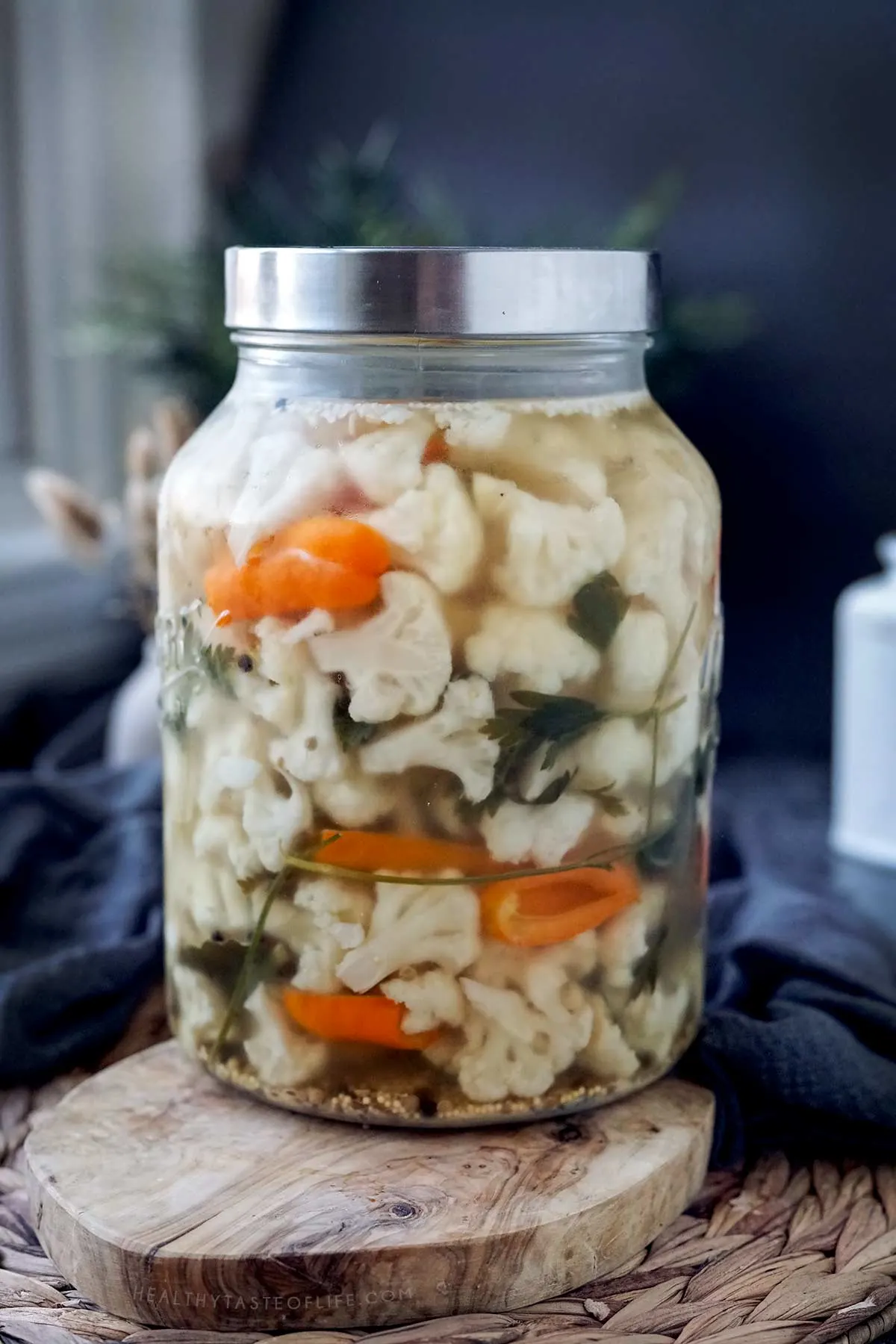

- Pairings: Pair your cauliflower with salads, sandwiches, or use it as a tangy side dish.
- Combinations:
- Spicy Fermented Cauliflower: Infuse your cauliflower ferment with a kick by adding chili flakes, jalapeños, or other hot peppers to the mix.
- Curried Fermented Cauliflower: Aromatic and flavorful, add curry powder or turmeric to your cauliflower for a delightful Indian-inspired ferment.
- Citrusy Fermented Cauliflower: Add lemon or lime zest to the brine, creating a refreshing and tangy fermented cauliflower variant.
- Garlic and Herb Fermented Cauliflower: Enhance your cauliflower with a medley of fresh herbs like dill or basil, and plenty of minced garlic for a flavorful twist.
- Pickled Medley: Combine cauliflower with other vegetables like carrots, onions, and colorful bell peppers, fermenting them together for a colorful and flavorful mix.
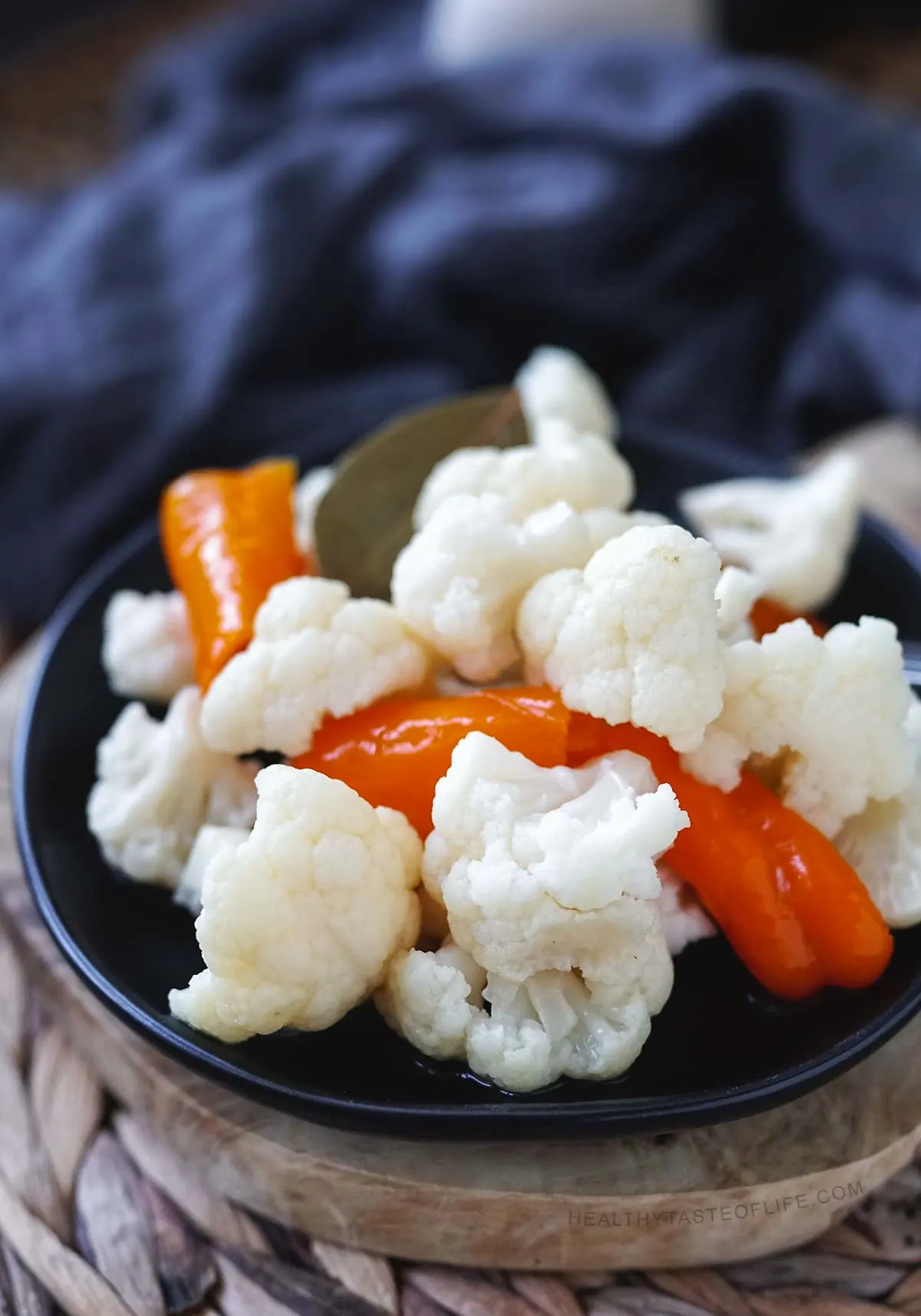
FAQs About Making Fermented Cauliflower
Properly fermented cauliflower will have a tangy smell and taste, with no signs of mold.
Absolutely! To create a vibrant and flavorful fermented medley, you can mix cauliflower with a variety of vegetables such as carrots, radishes, cucumbers, onions, green beans, bell peppers, chili peppers, broccoli, cabbage, and beets.
Fermented cauliflower just like many fermented vegetables has many health benefits: rich in probiotics, supports gut health, can enhance nutrient absorption by increasing their bioavailability to microbiota.
The fermentation process gives the cauliflower a pleasantly tangy and sour taste, reminiscent of pickles. Depending on the ingredients used, the cauliflower may also take on subtle notes of garlic, spice, or herbs. The texture becomes slightly softer yet retains a satisfying crunch, making fermented cauliflower a delightful and flavorful addition to various dishes.
More Fermenting Recipes
Printable Recipe
Lacto-Fermented Cauliflower Recipe
Ingredients
- 2.5 lb cauliflower florets - 1 to 1.2 kg
- 5-6 medium sweet peppers - bell peppers, or 2 -3 hot peppers
- 10-13 cloves garlic - fresh
- 3-4 bay leaves
- 4-5 parsley sprigs
Condiments
- 2 tsp whole coriander seeds
- 2 tsp whole mustard seeds
- 2 tsp whole black peppercorns
- 2 tsp dill seeds - whole
Brine
- 2000 ml filtered water - 67.63 fluid ounces
- 5.4 tbsp Celtic sea salt - 40 grams
Instructions
Prep Your Ingredients:
- Cut cauliflower into bite-sized florets and chop your sweet or hot peppers. Make sure everything has the same size. To fill a 1-gallon mason jar, which is equivalent to 128 fluid ounces or about 3.78 liters, you would typically need around 2 to 3 pounds (0.9 to 1.4 kg) of cauliflower florets. The exact amount can vary depending on the size and shape of the florets, as well as how tightly they are packed into the jar.
Create the Spice Mix:
- Combine black peppercorns, mustard seeds, coriander seeds, and dill seeds. I’m using 2 teaspoons of each.
Assemble:
- In a clean fermentation jar, layer the cauliflower, peppers, spice mix, garlic, parsley, and bay leaves.
- Prepare the Brine: Dissolve salt in water to create a brine solution. The salt-to-water ratio in a brine affects taste and fermentation speed. I usually use a 3% brine for fermenting cucumbers, but here I like the cauliflower to be tangier and I’ll be using a 4% brine solution (2.4 tablespoons of sea salt (or 2.7 tablespoons if using Celtic sea salt) in 4.2 cups of water which is ~1000 ml). For a 1 gallon jar you’ll need about 2000 ml of brine.
Submerge:
- Pour the brine over the vegetables, ensuring they are fully submerged.
Ferment:
- Place a clean, food-grade weight on top of the veggies after packing them into your jar. This weight will help keep everything below the surface of the brine. Aand let it sit at room temperature for 1 week or so, checking occasionally. A higher room teperature will speed up the fermentation process.
Taste and Store:
- Once fermented to your liking, transfer to the refrigerator.
What You Need
Notes
Nutrition
The information shown is an estimate provided by an online nutrition calculator.
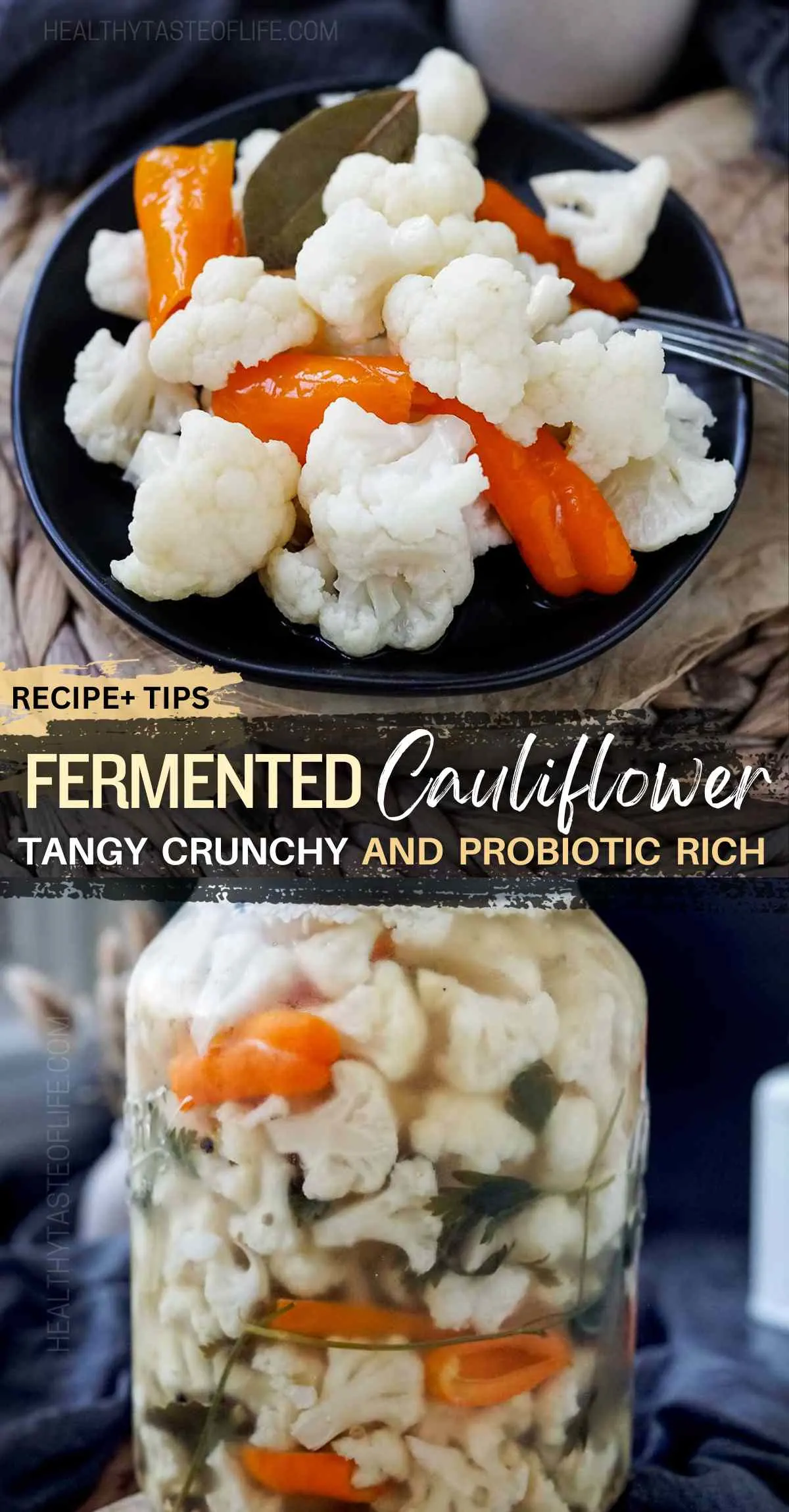
©HealthyTasteOfLife. Content and photographs are copyright protected and need prior permission to use. Copying and/or pasting full recipes to other websites and any social media is strictly prohibited. Sharing and using the link of this recipe is both encouraged and appreciated!


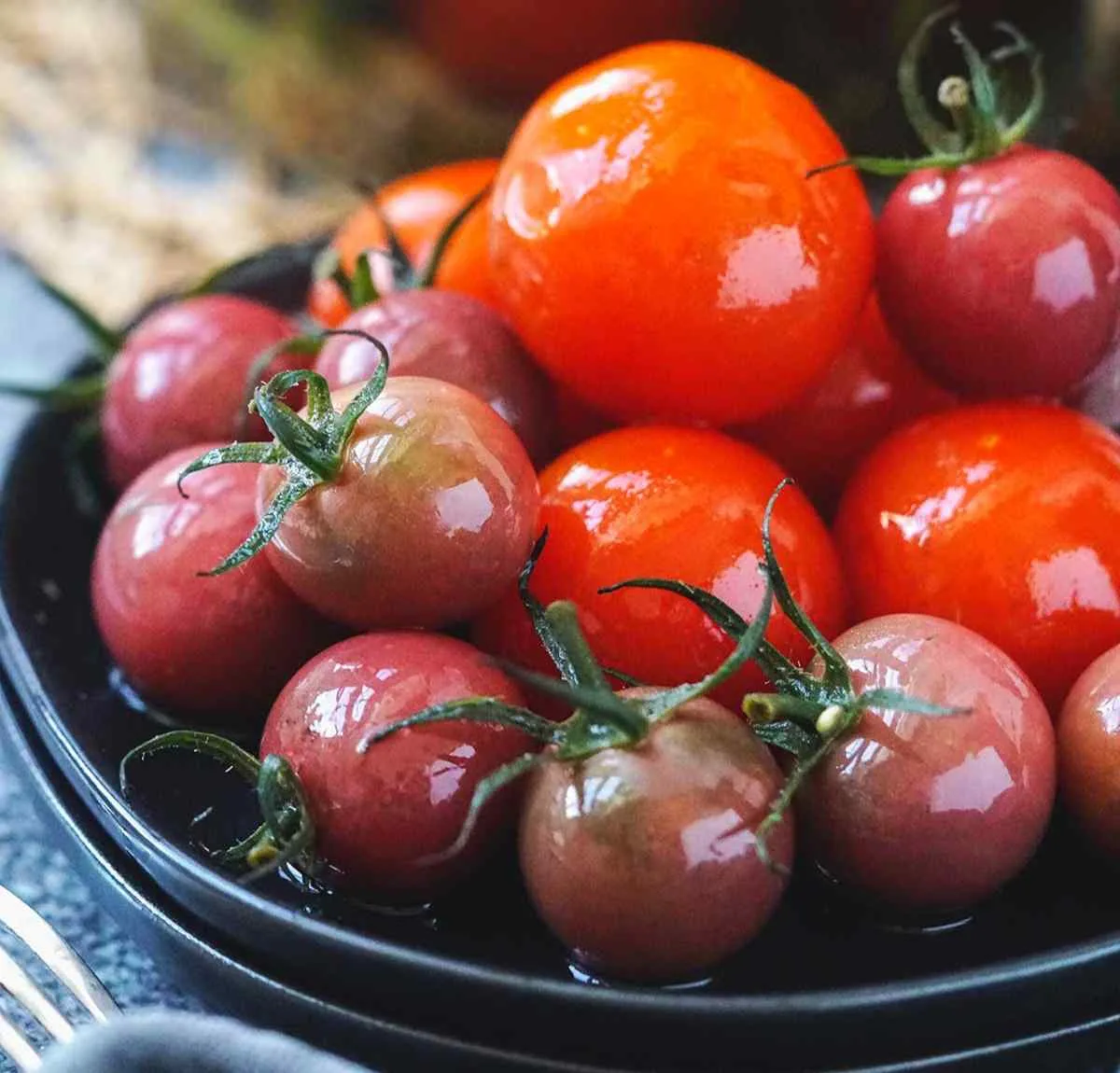

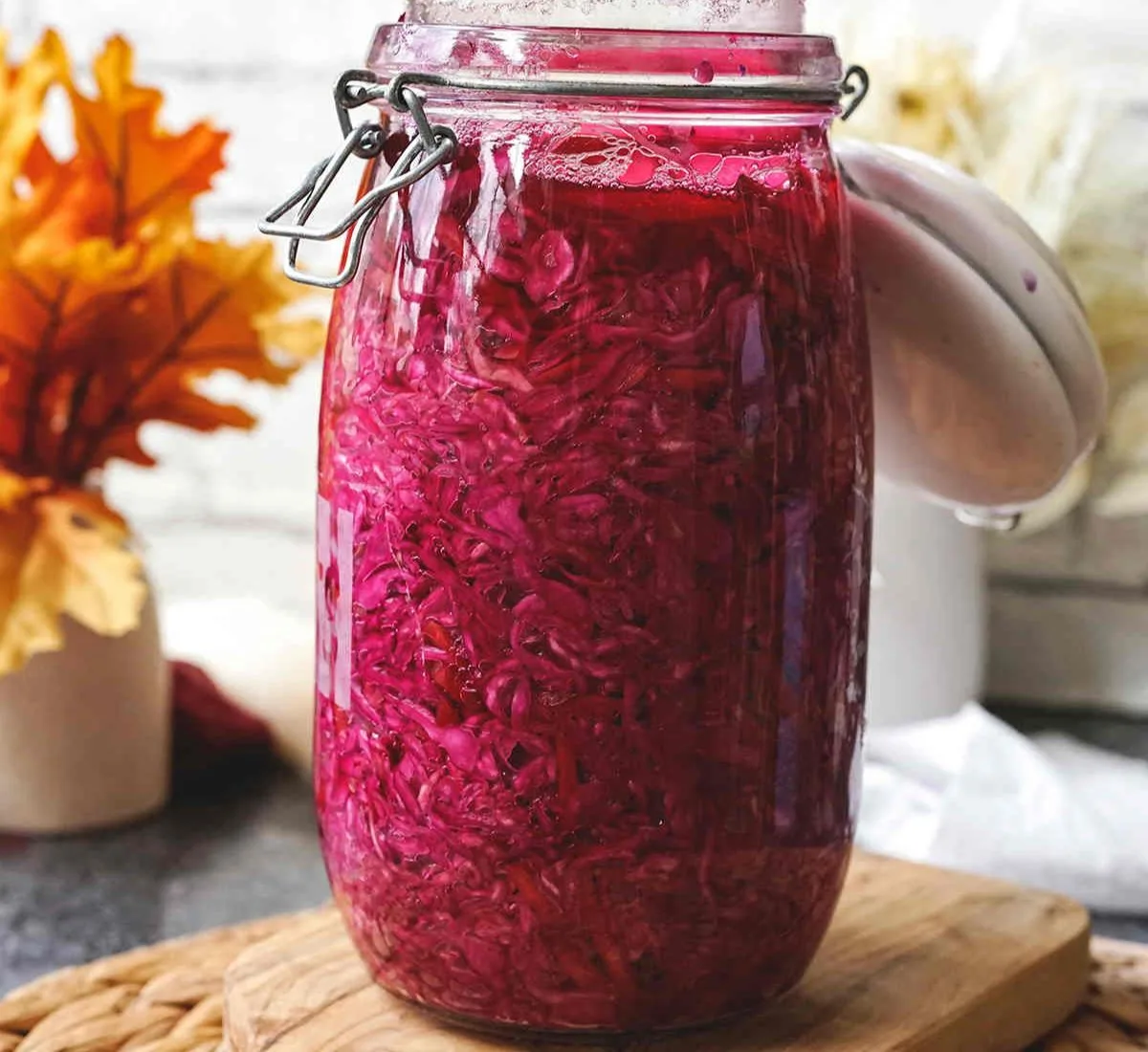
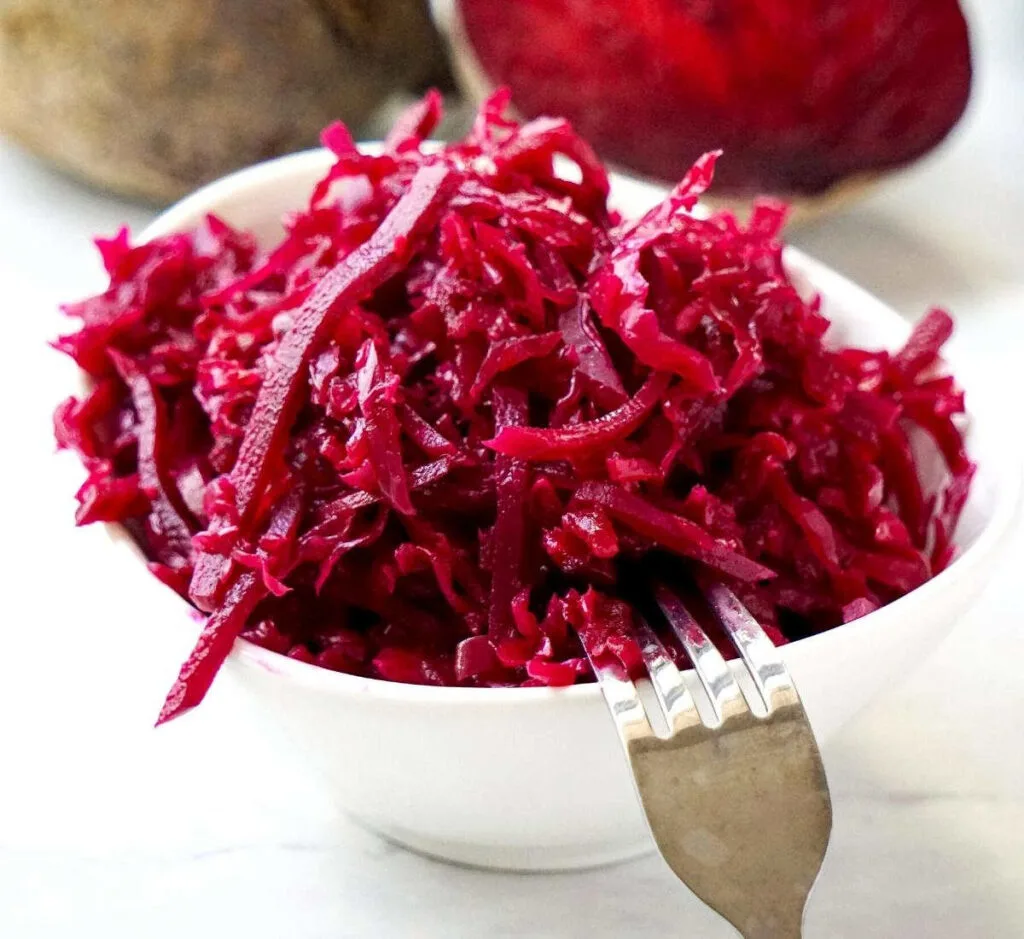
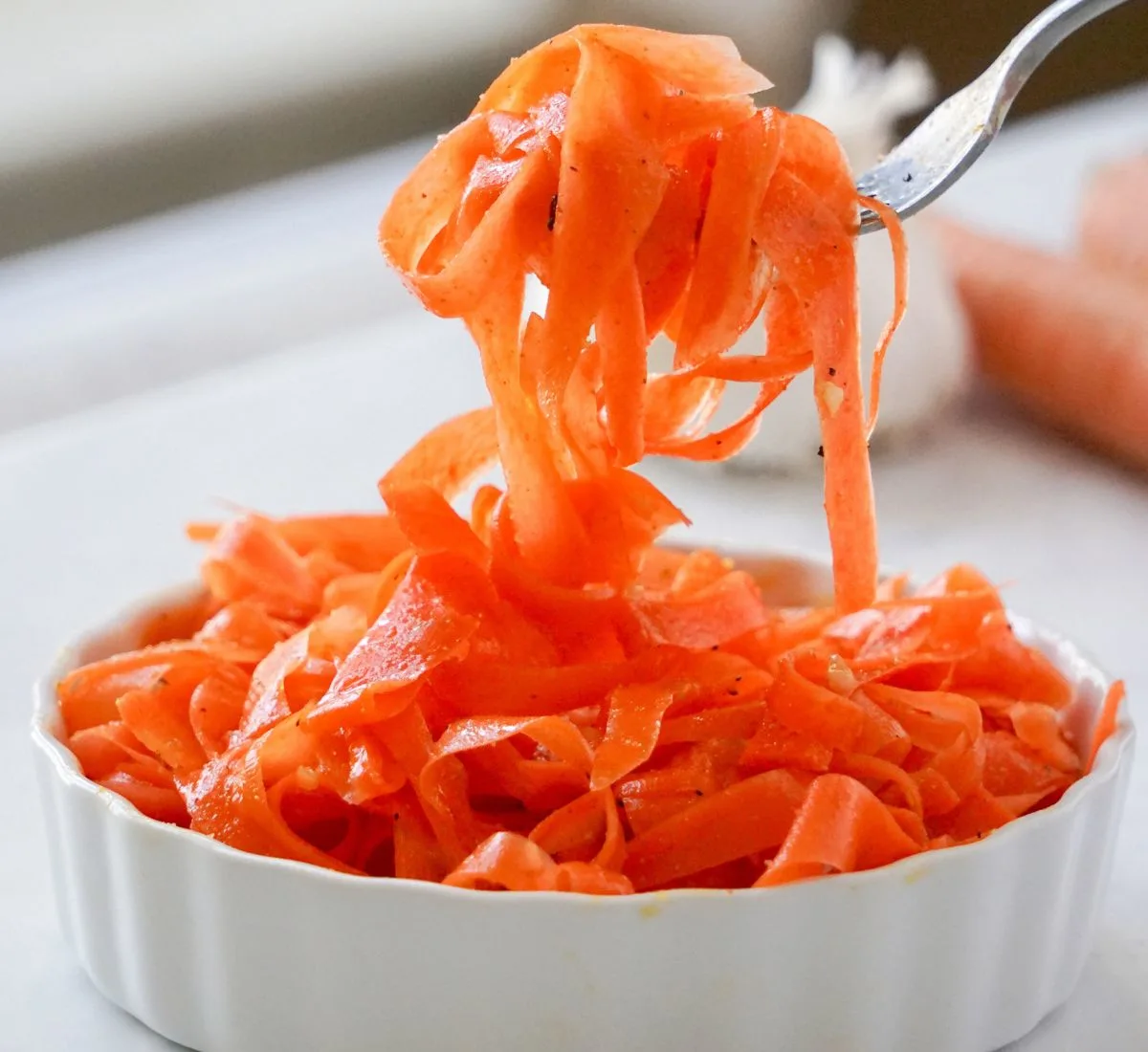
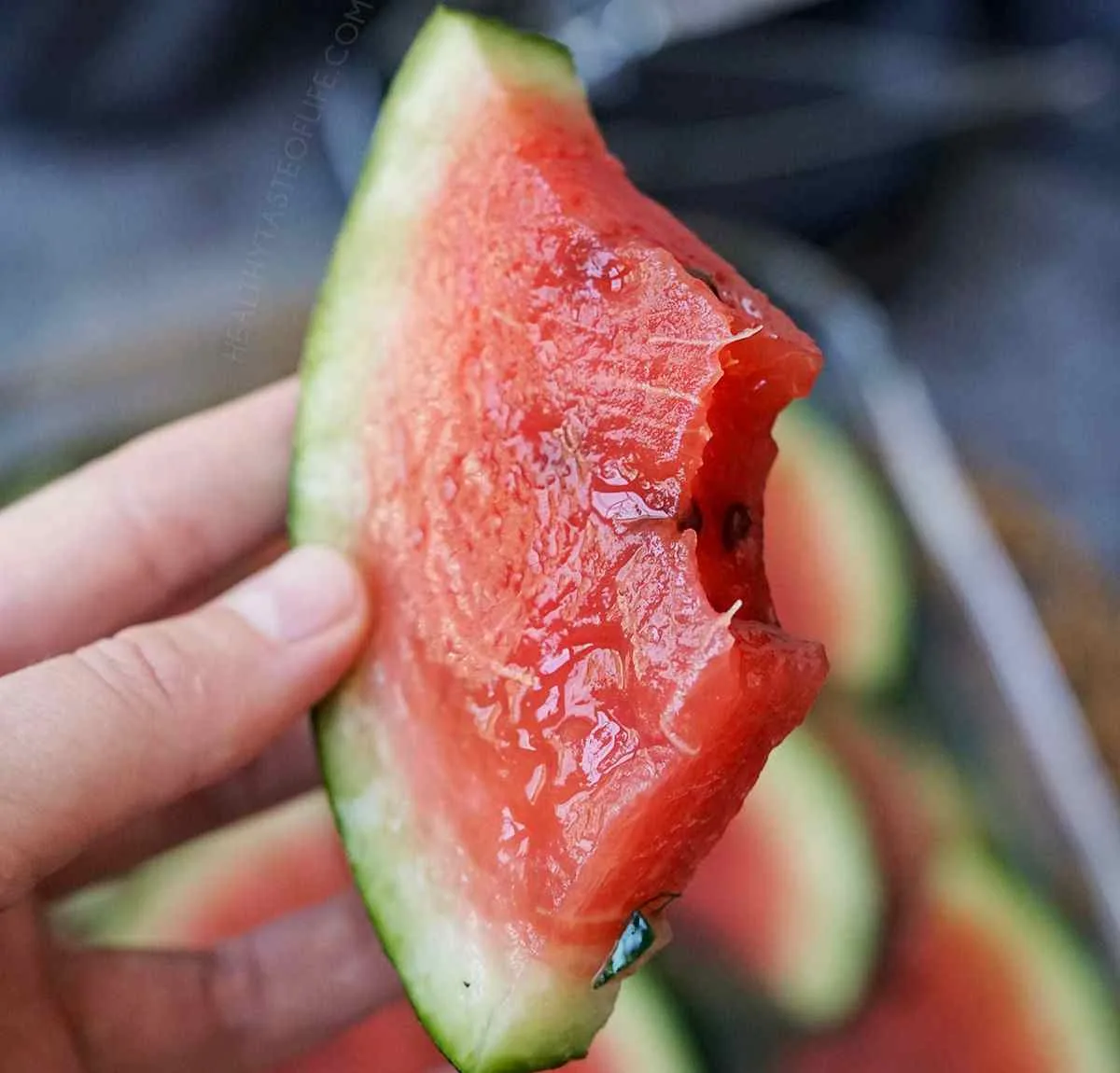

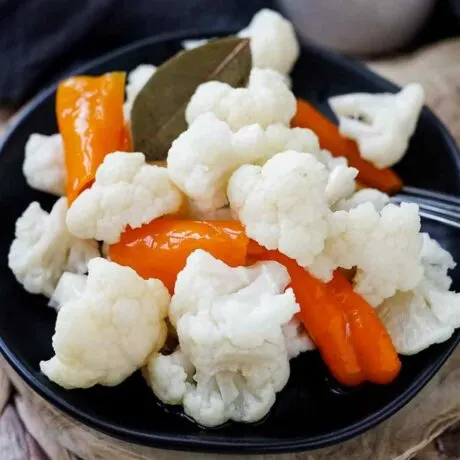

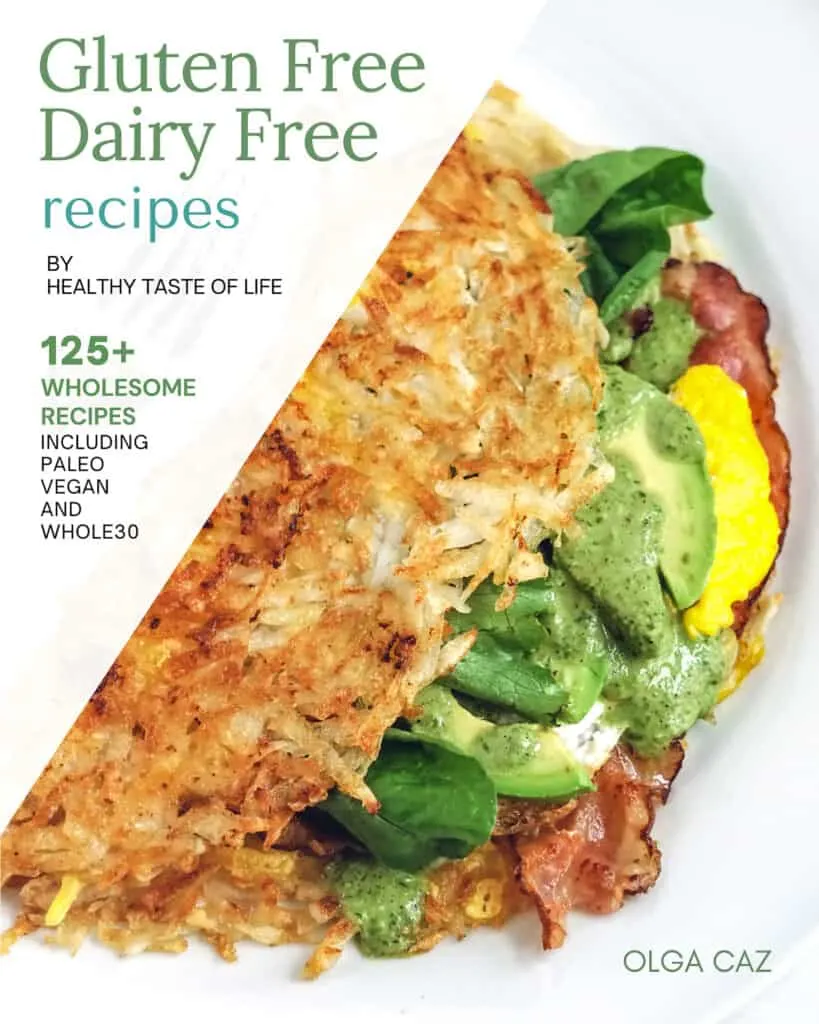
Hank
Friday 28th of June 2024
It came just right not oo salty and very satisfying!